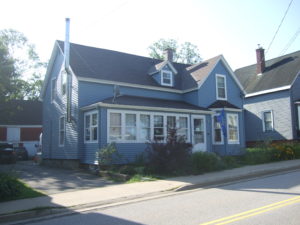232 St. Anthony Street
232 St. Anthony Street, Annapolis Royal, Nova Scotia, B0S 1A0, Canada
Formally Recognized: 1990/09/19
Other Name(s)
Bishop-Wentzell House
Links and Documents
Listed on the Canadian Register: 2009/03/23
Statement of Significance
Description of Historic Place
The Bishop-Wentzell House is a one-and-one-half storey structure built in the Late Victorian Plain style. The house is located in a neighbourhood of registered heritage properties of similar age and style in Annapolis Royal, NS. Both the house and property are included in the municipal heritage designation.Heritage Value
The Bishop-Wentzell House at 232 St. Anthony Street, as recognized by its heritage designation, is valued for its contribution to the architectural landscape of the town and its historical associations.Historic Value:
During the French period before 1710, St. Anthony Street (or Rue St-Antoine) was the second major street in town and met St. George Street at Fort Anne and the original government wharf. By the early 1800s activity gravitated to the waterfront away from this part of town, which was mainly agricultural and known as "Cooper Field." In 1869 the railway lines were constructed and the numerous houses that had occupied the Church of England Glebe land were removed to make way for a rail yard. Some of these dwellings were relocated to St. Anthony Street and the newly created St. James Street. The Bishop-Wentzell House was one of several new homes built in this section of the town. It was built circa 1885 by carpenter Albert Bishop. The house was purchased in 1912 by farmer Edgar A. Wentzell and was owned by members of the related Wentzell and McClafferty families until 2002.
Architectural Value:
The Bishop-Wentzell House is built in the Late Victorian Plain style. As with most houses in this style it has very simple decorative elements. This house differs from similar houses in the neighbourhood as the gable end does not face the road. It is turned so the section which is essentially the ell faces the road and acts as the front of the house. As with many buildings built in this style, the house has an enclosed entry porch running parallel to the street. The main decorative features of the house include a front bay window and a small gable dormer. These are in keeping with the simplicity of this style of working class building.
Source: Town of Annapolis Royal Heritage Property Files, Annapolis Heritage Society, Bishop-Wentzell House
Character-defining Elements
Character-defining elements of the Bishop-Wentzell House relate to its Late Victoria Plain style and include:- enclosed front porch with a modified hipped roof;
- front bay window;
- wooden clapboard siding and endboards;
- gable dormer on front elevation;
- boxed cornice;
- internal brick chimney rising at ridgeline;
- medium pitched gable roof;
- double hung wooden sash windows;
- plain window surrounds.
Recognition
Jurisdiction
Nova Scotia
Recognition Authority
Local Governments (NS)
Recognition Statute
Heritage Property Act
Recognition Type
Municipally Registered Property
Recognition Date
1990/09/19
Historical Information
Significant Date(s)
N/A
Theme - Category and Type
Expressing Intellectual and Cultural Life
Architecture and Design
Function - Category and Type
Current
Residence
Single Dwelling
Architect / Designer
N/A
Builder
Bishop, Albert
Additional Information
Location of Supporting Documentation
Annapolis Heritage Society 136 St George Street Annapolis Royal, Nova Scotia B0S 1A0
FED/PROV/TERR Identifier
02MNS0117












